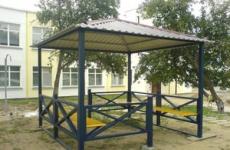Laws of ideal gases. The relationship between pressure, temperature, volume and number of moles of gas (the “mass” of gas). Universal (molar) gas constant R. Clayperon-Mendeleev equation = equation of state of an ideal gas At constant temperature
The relationship between pressure, temperature, volume and number of moles of gas (the “mass” of gas). Universal (molar) gas constant R. Clayperon-Mendeleev equation = equation of state of an ideal gas.
|
Limitations of practical applicability:
Within the range, the accuracy of the equation exceeds that of conventional modern engineering measuring instruments. It is important for the engineer to understand that significant dissociation or decomposition is possible for all gases as temperature increases. |
|
|
|
Let's solve a couple of problems regarding gas volumetric and mass flow rates under the assumption that the composition of the gas does not change (the gas does not dissociate) - which is true for most of the gases in the above.
This task is relevant mainly, but not only, for applications and devices in which gas volume is directly measured.
V 1 And V 2, at temperatures, respectively, T 1 And T 2 let it go T 1< T 2. Then we know that:
Naturally, V 1< V 2
- The lower the temperature, the more significant the indicators of the volumetric gas meter are.
- it is profitable to supply “warm” gas
- it is profitable to buy “cold” gas
How to deal with this? At least simple temperature compensation is required, that is, information from additional sensor temperature.
This task is relevant mainly, but not only, for applications and devices in which gas velocity is directly measured.
Let counter() at the delivery point give the volumetric accumulated costs V 1 And V 2, at pressures, respectively, P 1 And P2 let it go P 1< P2. Then we know that:
Naturally, V 1>V 2 for the same amounts of gas under given conditions. Let's try to formulate several practical conclusions for this case:
- The higher the pressure, the more significant the indicators of the gas volume meter are.
- it is profitable to supply gas low pressure
- profitable to buy high pressure gas
How to deal with this? At least simple pressure compensation is required, that is, information from an additional pressure sensor must be supplied to the counting device.
In conclusion, I would like to note that, theoretically, each gas meter should have both temperature compensation and pressure compensation. Practically......
Ideal gas isoprocesses– processes in which one of the parameters remains unchanged.
1. Isochoric process . Charles's law. V = const.
Isochoric process called a process that occurs when constant volume V. The behavior of the gas in this isochoric process obeys Charles' law :
At a constant volume and constant values of the gas mass and its molar mass, the ratio of gas pressure to its absolute temperature remains constant: P/T= const.
Graph of an isochoric process on PV-the diagram is called isochore . It is useful to know the graph of an isochoric process on RT- And VT-diagrams (Fig. 1.6). Isochore equation:
Where P 0 – pressure at 0 °C, α - temperature coefficient gas pressure equal to 1/273 deg -1. A graph of such a dependence on Рt-diagram has the form shown in Figure 1.7.

Rice. 1.7
2. Isobaric process. Gay-Lussac's law. R= const.
An isobaric process is a process that occurs at constant pressure P . The behavior of a gas during an isobaric process obeys Gay-Lussac's law:
At constant pressure and constant values of the mass of the gas and its molar mass, the ratio of the volume of the gas to its absolute temperature remains constant: V/T= const.
Graph of an isobaric process on VT-the diagram is called isobar . It is useful to know the graphs of the isobaric process on PV- And RT-diagrams (Fig. 1.8).

Rice. 1.8
Isobar equation:
Where α =1/273 deg -1 - temperature coefficient of volumetric expansion. A graph of such a dependence on Vt diagram has the form shown in Figure 1.9.

Rice. 1.9
3. Isothermal process. Boyle-Mariotte law. T= const.
Isothermal process is a process that occurs when constant temperature T.
The behavior of an ideal gas during an isothermal process obeys Boyle–Mariotte law:
At a constant temperature and constant values of the mass of the gas and its molar mass, the product of the volume of the gas and its pressure remains constant: PV= const.
Graph of an isothermal process on PV-the diagram is called isotherm . It is useful to know the graphs of an isothermal process on VT- And RT-diagrams (Fig. 1.10).

Rice. 1.10
Isotherm equation:
| (1.4.5) |
4. Adiabatic process(isentropic):
Adiabatic process – thermodynamic process, occurring without heat exchange with the environment.
5. Polytropic process. A process in which the heat capacity of a gas remains constant. The polytropic process is a general case of all the processes listed above.
6. Avogadro's law. At the same pressures and the same temperatures, equal volumes of different ideal gases contain the same number of molecules. In one mall various substances contains N A=6.02·10 23 molecules (Avogadro's number).
7. Dalton's law. The pressure of a mixture of ideal gases is equal to the sum of the partial pressures P of the gases included in it:
| (1.4.6) |
Partial pressure Pn is the pressure that a given gas would exert if it alone occupied the entire volume.
At ![]() , gas mixture pressure.
, gas mixture pressure.
Ideal gas equation of state determines the relationship between temperature, volume and pressure of bodies.
- Allows you to determine one quantity characterizing the state of a gas from two others (used in thermometers);
- Determine how processes proceed under certain external conditions;
- Determine how the state of the system changes if it does work or receives heat from external bodies.
Mendeleev-Clapeyron equation (ideal gas equation of state)
- universal gas constant, R = kN A
Clapeyron's equation (united gas law)
Special cases of the equation are gas laws that describe isoprocesses in ideal gases, i.e. processes in which one of the macroparameters (T, P, V) in a closed isolated system is constant.
Quantitative relationships between two parameters of a gas of the same mass with a constant value of the third parameter are called gas laws.
Gas laws
Boyle's Law - Mariotte
The first gas law was discovered by the English scientist R. Boyle (1627-1691) in 1660. Boyle’s work was called “New Experiments Concerning an Air Spring.” Indeed, gas behaves like a compressed spring; this can be verified by compressing air in a regular bicycle pump.
Boyle studied the change in gas pressure as a function of volume at constant temperature. The process of changing the state of a thermodynamic system at a constant temperature is called isothermal (from the Greek words isos - equal, therme - heat).
Independently of Boyle, somewhat later, the French scientist E. Marriott (1620-1684) came to the same conclusions. Therefore, the found law was called the Boyle-Mariotte law.
The product of the pressure of a gas of a given mass and its volume is constant if the temperature does not change
pV = const
Gay-Lussac's Law
The discovery of another gas law was published only in 1802, almost 150 years after the discovery of the Boyle-Mariotte law. The law defining the dependence of gas volume on temperature at constant pressure (and constant mass) was established by the French scientist Gay-Lussac (1778-1850).
The relative change in the volume of a gas of a given mass at constant pressure is directly proportional to the change in temperature
V = V 0 αT
Charles's Law
The dependence of gas pressure on temperature at constant volume was experimentally established by the French physicist J. Charles (1746-1823) in 1787.
J. Charles in 1787, i.e., earlier than Gay-Lussac, established the dependence of volume on temperature at constant pressure, but he did not publish his works in a timely manner.
The pressure of a given mass of gas at constant volume is directly proportional to the absolute temperature.
p = p 0 γT
| Name | Formulation | Charts |
|
Boyle-Mariotte law – isothermal process |
For a given mass of gas, the product of pressure and volume is constant if the temperature does not change |
   |
|
Gay-Lussac's Law – isobaric process |
Let's make sure that the gas molecules are really located far enough from each other, and therefore the gases are well compressible. Let's take a syringe and place its piston approximately in the middle of the cylinder. Connect the hole of the syringe to a tube, the second end of which is tightly closed. Thus, some air will be enclosed in the syringe barrel under the piston and in the tube.In the syringe barrel under the piston some air will be enclosed. Now let’s place a weight on the movable piston of the syringe. It is easy to notice that the piston will drop slightly. This means that the volume of air has decreased. In other words, gases are easily compressed. Thus, there are quite large gaps between gas molecules. Placing a weight on the piston causes the volume of gas to decrease. On the other hand, after installing the load, the piston, having dropped slightly, stops in a new equilibrium position. This means that air pressure force on the piston increases and again balances the increased weight of the piston with the load. And since the area of the piston remains unchanged, we come to an important conclusion.
As the volume of a gas decreases, its pressure increases.
Let us remember at the same time that the mass of the gas and its temperature remained unchanged during the experiment. The dependence of pressure on volume can be explained as follows. As the volume of a gas increases, the distance between its molecules increases. Each molecule now needs to travel a greater distance from one impact with the wall of the vessel to the next. The average speed of movement of the molecules remains unchanged. Consequently, gas molecules hit the walls of the vessel less often, and this leads to a decrease in gas pressure. And, conversely, when the volume of a gas decreases, its molecules hit the walls of the container more often, and the gas pressure increases. As the volume of a gas decreases, the distance between its molecules decreases
Dependence of gas pressure on temperature
In previous experiments, the temperature of the gas remained constant, and we studied the change in pressure due to a change in the volume of the gas. Now consider the case when the volume of gas remains constant, but the temperature of the gas changes. The mass also remains unchanged. Such conditions can be created by placing a certain amount of gas in a cylinder with a piston and securing the piston
Change in temperature of a given mass of gas at a constant volume
The higher the temperature, the faster gas molecules move.
Therefore,
Firstly, molecules hit the walls of the vessel more often;
Secondly, the average force of impact of each molecule on the wall becomes greater. This brings us to another important conclusion. As the temperature of a gas increases, its pressure increases. Let us remember that this statement is true if the mass and volume of the gas remain unchanged as its temperature changes.
Storage and transportation of gases.
The dependence of gas pressure on volume and temperature is often used in technology and in everyday life. If it is necessary to transport a significant amount of gas from one place to another, or when gases need to be stored for a long time, they are placed in special durable metal vessels. These vessels can withstand high pressures, so with the help of special pumps, significant masses of gas can be pumped into them, which under normal conditions would occupy hundreds of times more volume. Since the gas pressure in the cylinders is very high even at room temperature, they should never be heated or in any way attempted to make a hole in them, even after use.
Gas laws of physics.
Real world physics in calculations is often reduced to somewhat simplified models. This approach is most applicable to describing the behavior of gases. The rules established experimentally were compiled by various researchers into the gas laws of physics and gave rise to the concept of “isoprocess.” This is a passage of an experiment in which one parameter remains constant. The gas laws of physics operate on the basic parameters of gas, or more precisely, its physical state. Temperature, occupied volume and pressure. All processes that relate to changes in one or more parameters are called thermodynamic. The concept of an isostatic process comes down to the statement that during any change in state, one of the parameters remains unchanged. This is the behavior of the so-called “ideal gas”, which, with some reservations, can be applied to real matter. As noted above, the reality is somewhat more complicated. However, with high reliability the behavior of a gas at a constant temperature is characterized using the Boyle-Mariotte law, which states:
The product of volume and gas pressure is a constant value. This statement is considered true in the case when the temperature does not change.
This process is called “isothermal”. In this case, two of the three parameters under study change. Physically everything looks simple. Squeeze the inflated balloon. The temperature can be considered constant. As a result, the pressure inside the ball will increase as the volume decreases. The value of the product of two parameters will remain unchanged. Knowing the initial value of at least one of them, you can easily find out the indicators of the second. Another rule in the list of “gas laws of physics” is the change in the volume of a gas and its temperature at the same pressure. This is called an "isobaric process" and is described using Gay-Lusac's law. The ratio of gas volume and temperature is unchanged. This is true provided that the pressure in a given mass of substance is constant. Physically, everything is simple too. If you've charged it at least once gas lighter or used a carbon dioxide fire extinguisher and saw the effect of this law “live.” Gas coming out of a can or fire extinguisher expands rapidly. His temperature drops sharply. You can freeze the skin of your hands. In the case of a fire extinguisher, whole flakes of carbon dioxide snow are formed when the gas, under the influence of low temperature, quickly turns into a solid state from a gaseous state. Thanks to Gay-Lusac's law, you can easily find out the temperature of a gas by knowing its volume at any given time. The gas laws of physics also describe behavior under the condition of a constant occupied volume. Such a process is called isochoric and is described by Charles’s law, which states: With a constant occupied volume, the ratio of pressure to gas temperature remains unchanged at any time. In reality, everyone knows the rule: you cannot heat air freshener cans and other vessels containing gas under pressure. It ends with an explosion. What happens is exactly what Charles's law describes. The temperature is rising. At the same time, the pressure increases, since the volume does not change. The cylinder is destroyed at the moment when the indicators exceed the permissible values. So, knowing the occupied volume and one of the parameters, you can easily set the value of the second. Although the gas laws of physics describe the behavior of an ideal model, they can be easily applied to predict the behavior of gases in real systems. Especially in everyday life, isoprocesses can easily explain how a refrigerator works, why a cold stream of air flies out of a air freshener can, why a chamber or ball bursts, how a sprinkler works, and so on.
Fundamentals of MCT.
Molecular kinetic theory of matter- way of explanation thermal phenomena, which connects the occurrence of thermal phenomena and processes with the characteristics of the internal structure of matter and studies the reasons that determine thermal movement. This theory gained recognition only in the 20th century, although it comes from the ancient Greek atomic theory of the structure of matter.
explains thermal phenomena by the peculiarities of the movement and interaction of microparticles of matter
It is based on the laws of classical mechanics of I. Newton, which allow us to derive the equation of motion of microparticles. However, due to their huge number (there are about 10 23 molecules in 1 cm 3 of substance), it is impossible every second to unambiguously describe the movement of each molecule or atom using the laws of classical mechanics. Therefore, to construct modern theory heat uses methods of mathematical statistics that explain the flow of thermal phenomena based on patterns of behavior significant amount microparticles
Molecular kinetic theory built on the basis of generalized equations of motion for a huge number of molecules.
Molecular kinetic theory explains thermal phenomena from the standpoint of ideas about internal structure substances, that is, finds out their nature. This is a deeper, albeit more complex theory that explains the essence of thermal phenomena and determines the laws of thermodynamics.
Both existing approaches - thermodynamic approach And molecular kinetic theory- scientifically proven and mutually complement each other, and do not contradict each other. In this regard, the study of thermal phenomena and processes is usually considered from the standpoint of either molecular physics or thermodynamics, depending on how it is easier to present the material.
Thermodynamic and molecular-kinetic approaches complement each other in explaining thermal phenomena and processes.
The amount of air in cylinders depends on the volume of the cylinder, air pressure and its temperature. The relationship between air pressure and its volume at a constant temperature is determined by the relationship
where р1 and р2 are the initial and final absolute pressure, kgf/cm²;
V1 and V2 - initial and final volume of air, l. The relationship between air pressure and its temperature at a constant volume is determined by the relationship
where t1 and t2 are the initial and final air temperatures.
Using these dependencies, you can solve various problems that you encounter in the process of charging and operating air-breathing apparatus.
Example 4.1. The total capacity of the apparatus cylinders is 14 liters, the excess air pressure in them (according to the pressure gauge) is 200 kgf/cm². Determine the volume of free air, i.e. the volume reduced to normal (atmospheric) conditions.
Solution. Initial absolute atmospheric air pressure p1 = 1 kgf/cm². Final absolute pressure of compressed air p2 = 200 + 1 = 201 kgf/cm². The final volume of compressed air V 2 = 14 l. Volume of free air in cylinders according to (4.1)
Example 4.2. From a transport cylinder with a capacity of 40 liters with a pressure of 200 kgf/cm² (absolute pressure 201 kgf/cm²), air was transferred into the apparatus cylinders with a total capacity of 14 liters and a residual pressure of 30 kgf/cm² (absolute pressure 31 kgf/cm²). Determine the air pressure in the cylinders after air bypass.
Solution. Total volume of free air in the system of transport and equipment cylinders according to (4.1)
Total volume of compressed air in the cylinder system
Absolute pressure in the cylinder system after air bypass
excess pressure = 156 kgf/cm².
This example can be solved in one step by calculating the absolute pressure using the formula
Example 4.3. When measuring the air pressure in the apparatus cylinders in a room with a temperature of +17° C, the pressure gauge showed 200 kgf/cm². The device was taken outside, where a few hours later, during a working check, a pressure drop on the pressure gauge was discovered to 179 kgf/cm². The outside air temperature is -13° C. There is a suspicion of air leakage from the cylinders. Check the validity of this suspicion using calculations.
Solution. The initial absolute air pressure in the cylinders is p1 = 200 + 1 = 201 kgf/cm², the final absolute pressure p2 = 179 + 1 = 180 kgf/cm². Initial air temperature in cylinders t1 = + 17° C, final temperature t2 = - 13° C. Calculated final absolute air pressure in cylinders according to (4.2)
Suspicions are unfounded, since the actual and calculated pressures are equal.
Example 4.4. A submarine swimmer underwater consumes 30 l/min of air compressed to a pressure of a diving depth of 40 m. Determine the free air consumption, i.e., convert to atmospheric pressure.
Solution. Initial (atmospheric) absolute air pressure p1 = l kgf/cm². The final absolute pressure of compressed air according to (1.2) р2 =1 + 0.1*40 = 5 kgf/cm². Final compressed air flow V2 = 30 l/min. Free air flow according to (4.1)







